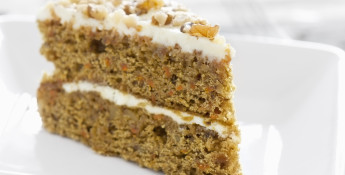By Karen Hanson on August 7, 2017
The Replacements
Swap ingredients for healthier meals

We all enjoy sugar, butter and salt, but these foods can wreak havoc on your nutrition goals. Not to mention, some ingredient swaps are necessary for people with special dietary needs due to food allergies. Karen Hanson, dietitian for the Johnson County Department of Health and Environment, suggests some alternatives for creating healthier dishes without sacrificing flavor.
“There are a lot of great options to reduce the amount of sugar, sodium and fat in recipes,” Hanson says. “A good idea to help you remember these is to print them out and tape them inside a cupboard so you have a reference point when you cook.”
UNSWEETEN YOUR SUGAR
An easy swap is to use unsweetened applesauce in place of sugar, which gives the necessary sweetness without adding refined sugar.
“You can substitute applesauce for sugar in a one-to-one ratio, but for every cup of applesauce you use, reduce the amount of liquid in the recipe by ¼ cup,” Hanson says.
For another sweet option, try a sugar substitute such as Stevia, a sweetener which is extracted from the leaves of the plant species Stevia rebaudiana. The powder derived from Stevia is 200 to 300 times sweeter than sugar, so it only takes a small amount to sweeten foods and drinks. Stevia also doesn’t add calories or affect blood sugar or insulin levels, and it’s better for those pearly whites.
For chocolate lovers, try using only half the amount of chocolate chips called for, and substituting mini chocolate chips for regular or chunk-sized.
“Using fewer chocolate chips cuts calories, carbohydrates, sugar, fat and saturated fat,” Hanson says. “Mini chocolate chips go further so it doesn't seem as though there are fewer of them.”
For one ounce of unsweetened baking chocolate, substitute three tablespoons natural, unsweetened cocoa or carob powder plus one tablespoon vegetable oil, canola oil or soft margarine.
Another great way to reduce sugar intake is to substitute it with something just as tasty. Use spices that enhance the flavor and sweetness of a dish, such as cinnamon, cloves, allspice, ginger and nutmeg. Fruit purees or fresh fruits such as berries are excellent when used as a dessert topping in place of icing or glazes made from sugar.
BUTTER REPLACEMENT
Another great use of unsweetened applesauce is as a butter replacement. If you need to keep dairy away, unsweetened applesauce provides the right texture with a hint of sweetness.
“This trick works well in any from-scratch quick bread, like zucchini or banana bread, but also works in pre-boxed mixes,” Hanson says. “Try swapping out half the fat. For instance, a recipe using one cup butter would use 1/2 cup oil and 1/2 cup applesauce. The oil offers a healthier type of oil that is less saturated.”
Other options to replace butter include prune puree — for use in dark baked goods such as brownies — and chia seeds.
“To swap chia seeds for butter, combine one tablespoon chia seeds with nine tablespoons water, then let sit for 15 minutes,” Hanson says. “You create a gel that has the right consistency to stand in for fat in baking recipes.”
HOW LOW CAN YOUR SODIUM GO
Too much salt in your diet can negatively affect your blood pressure, which can place an added strain on your heart, arteries, kidneys and brain. Having too much salt in your diet can increase your chance of a heart attack, stroke and kidney disease.
“Lowering your salt intake is really easy,” Hanson says. “There are a lot of low-sodium alternatives at the grocery
store and in restaurants, such as reduced-sodium soy sauce at Chinese and sushi restaurants. Also look for “no salt added” when buying canned vegetables and sauces.”
Other ways to reduce your sodium intake include replacing salt with seasoning powders. One example is using garlic powder, not garlic salt. Replace those breadcrumbs with rolled oats seasoned with thyme and rosemary so you don’t skip out on any flavor. You can even use fresh herbs and citrus to add flavor while reducing sodium.
MORE WAYS TO SUBSTITUTE
“Using lower-fat or no-fat ingredients can help minimize the total amount of dietary fat you consume,” Hanson says. “These healthy substitutions can help you cut down on saturated or trans fats, but you won’t sacrifice any flavor.”
If a recipe calls for one cup of whole milk, replace with one cup of fat-free or low-fat milk, plus one tablespoon of liquid vegetable oil.
To replace one cup of heavy cream, use 1/2 cup low-fat yogurt and 1/2 cup low-fat cottage cheese blended together until smooth.
Instead of regular sour cream, use light or fat-free sour cream. Cream cheese also comes in light or fat-free versions as well.
“There are a lot of options when it comes to lowering the amount of sugar, dietary fat and salt in recipes,” Hanson says. “With a little planning ahead and experimenting, you can still deliver delicious dishes with your health in mind.”
For A CARROT CAKE RECIPE WITH REPLACEMENT EXAMPLES:



